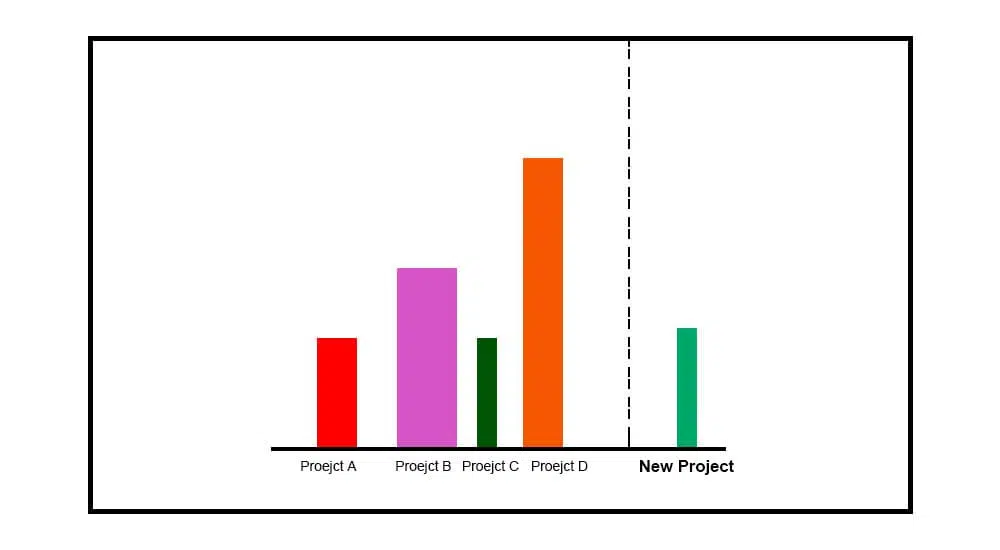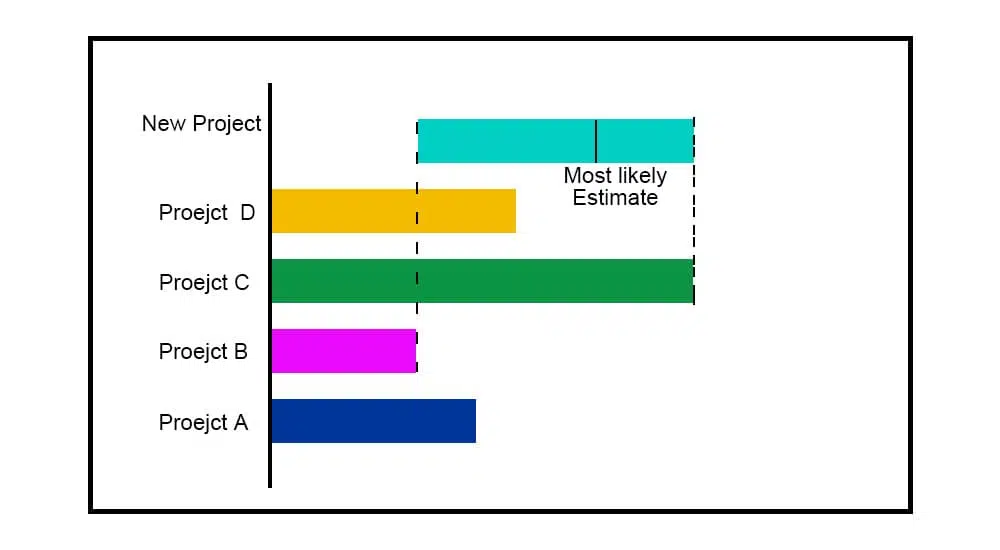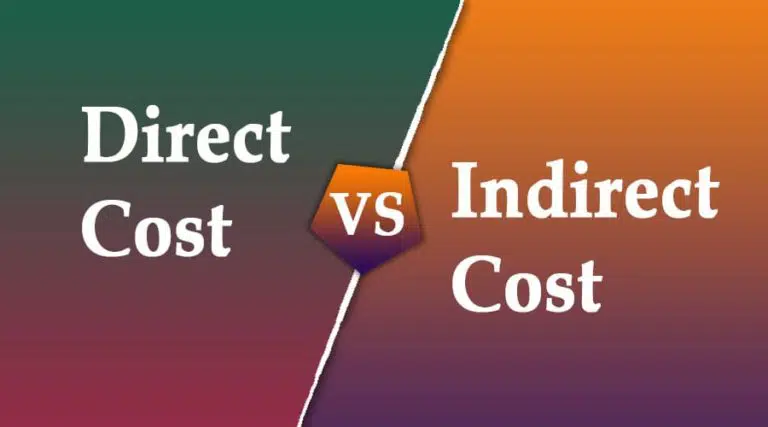Today, we will discuss the cost and schedule estimation technique called analogous estimation.
Project managers often need to make a project cost or duration prediction with limited information.
For example, the management needs an initial budget to perform a cost-benefit analysis for a feasibility study.
There is no detailed project scope available. However, you have successfully finished projects that were similar in the past. Therefore, to calculate the budget, you will employ a method of estimating analogous to the previous one.
When you need a quick estimation but only have access to high-level information, this method can be helpful.
Analogous Estimation
Analogous estimating is a quantitative technique to estimate effort, duration, or cost.
A rough estimation can be calculated with the help of analogous estimation, and it requires very little information about the project. This forecast’s accuracy relies on both your prior work experience and the degree to which your current endeavor is comparable to previous endeavors.
The estimation from this technique is a rough order of magnitude, and the accuracy is between -25 to +75%
Analogous estimation is also known as a top-down estimation because the overall project is predicted first. Individual tasks are then apportioned by considering the judgment of experienced experts.
This technique is less accurate because it relies on judgment, but estimations can be done quickly. This is the most effective way to proceed when insufficient information is available.
Within the work breakdown structure context, you are free to apply this method with any level of granularity you see fit. However, most of the time, it is employed in the early stages of estimating entire projects or larger components of a project.
Examples of Analogous Estimation
Your organization has a project to develop Graphical User Interface software for a community bus transit website. You have completed a similar project, and it took two months at 20,000 USD.
However, the current project doesn’t need sophisticated websites, and the traffic is low compared to the current project, so they might not need high-end servers. Based on this data, expert estimators can come to a single-point estimate of 17,000 USD.
Different Types of Analogous Estimation Techniques
Analogous estimating provides four types of estimates:
- Single Point Estimate
- Ratio Estimate
- Estimate Range
- Three-Point Estimate
#1. Single Point Estimate
This estimate is also known as an absolute estimate. In this estimate, the estimation result provides a single absolute value.

For example, you find a past similar project with a value of 250,000 USD, and your project is similar to this one in size and technicalities, so the analogous estimate for your project would be 250,000 USD.
#2. Ratio Estimate
Using this method of estimating, you can apply data from previous projects to the one you are working on now. The cost of a project is said to be linear to one or more of its deliverables when using this methodology. For instance, the cost of the materials and equipment used in a construction project accounts for only half of the total estimated project cost.
As an illustration, you might say that the current project will cost approximately 200% more than the project that came before it.
This approach considers a linear relationship between the various facets or between a complete facet and the overall project.
#3. Estimate Range
In place of a single estimate, the results of a range estimate are presented as a range of possible values. The three-point estimate is a common method that indicates the range of the estimate.
Analogous estimates are not accurate. To increase the likelihood of accurately determining the project’s total cost, the estimator needs to provide the value that is most likely to occur and the complete spectrum of all values that could occur.
Because there is limited visibility in the early stages of an adaptive or agile project, this method is primarily used to manage those projects. For example, a project team offers the following ranges for the costs of a new graphic interface: three to eight resource months and 150,000 USD to 320,000 USD.

Three-Point Estimate
Here, you use three different estimates and then PERT or triangular estimate to arrive at a single estimate.
These three estimates are
- Optimistic Estimate
- Most Likely Estimate
- Pessimistic Estimate
PERT is a sophisticated form of the range estimation technique. Three separate values for the project’s cost (or duration) or the cost of individual elements are averaged: optimistic, pessimistic, and most likely.
PERT analysis uses a statistical probability to calculate an expected proposed value based on a weighted average of the three values. The most likely data is weighted by four times its value to reinforce its significance. The PERT formula is E = (O + 4ML + P)/6, which results in a beta distribution formula.
Analogous Estimation Requirements
Analogous estimating requires the following information:
- Complete data from past similar projects.
- Input from the subject matter experts and experienced team members.
- Participation from the project team members and cost estimation experts.
Inputs to Analogous Estimation Technique
Estimation Information
- It is advisable to validate the quality of the information gathered before using the analogous estimation approach. Suppose the new project estimation is based on previous data. In that case, it is important to check that it is appropriate for the project’s culture and circumstances to eliminate any room for ambiguity or assumptions.
- All estimations should be based on the success criteria and definition of done. These two factors are key in ensuring actual work meets the planned work.
Estimators
- Estimators should be experienced, subject matter experts.
- Each individual must know their capabilities and take ownership of their work, so their estimates will be accurate.
Enterprise Environmental Factors and Organizational Process Assets
- Enterprise environmental factors influence the quality and accuracy of an estimate.
- Organizational process assets, such as estimating tools, techniques, procedures, or models, should be identified when they are used.
Independent Project Estimates
- Independent project estimates by an independent party are required in some industries and regulated environments.
- Independent estimates can differ from project team estimates. Normalization should be applied to both.
Outputs of Analogous Estimation Technique
Completed Estimates
- Estimates for activity duration, activity resources, and costs are the key outputs. The output is a prediction of the project outcome, not definitive values.
Basis of Estimates
- The methodology behind the estimation can be found in this project document. They provide a clear and comprehensive understanding while demonstrating the level of detail involved. This includes information regarding assumptions, units, or factors and comparative data. This documentation ought to also include a listing of the risks involved and the items that are on the assumption log.
Normalized Historical Data
- The normalizing factors to be considered include project completion, project execution location, changes in productivity metrics, quality metrics, final specific product characteristics, etc.
- A good estimation process should include historical lessons learned.
How to Use Analogous Estimation
You can use the following steps to apply analogous estimating:
- Prepare a list of the previous projects.
- Separate the projects which are similar to the current project.
- Collect details of these projects such as cost, duration, the scope of work, risks, etc.
- Determine the type of estimation to be used based on the available data and stakeholders’ requirements.
- Select and calculate the estimate.
Analogous Vs Parametric Estimating
Both approaches utilize historical data but in very different ways. Analogous takes a much more border view, whereas parametric estimation takes data from the previous project and mathematically uses it in the estimation with adjustments. Both methods consider similar factors.
For instance, a parametric estimation can calculate the cost of plaster works by considering the price of plaster per square foot and then applying that price to the current project.
Analogous estimating does not require adjustment.
The accuracy that can be achieved through the use of parametric estimation is superior to that which can be achieved through the use of analogous estimation. However, unlike analogous estimation, parametric estimation calls for a greater investment of resources and necessitates collecting additional data.
Advantages of Analogous Estimation Technique
- Requires minimal project details, is faster, easier, and less expensive.
- Useful when cost estimates are needed in the very early phases of a project.
- Allows you to focus on system-level activities like integration, documentation, and configuration management. System-level activities are often ignored by estimating methods.
- Greater commitment and support from senior management.
- Effective features like cost-time trade-off capability provide a global view of the project, etc.
Disadvantages of Analogous Estimation Technique
- Sometimes provides false estimation due to limited information.
- Inappropriate historical examples could be used.
- Can overlook low-level components and often do not identify difficult low-level problems.
- Does not provide any detailed basis for justifying decisions or estimates.
Conclusion
Analogous estimation is a useful technique to predict project cost estimation quickly when limited information is available. Although the result is not accurate, it provides a reason for management to go ahead with a cost-benefit or feasibility analysis.
Once management approves, you can use other estimation techniques and find an accurate estimate.
Please note that if you are preparing for the PMP certification exam, this is an important topic. There is a possibility that some of the questions on the exam will be based on the analogous estimation technique.
Has analogous estimation helped you with your projects? If you have anything to add, please use the comments section.

I am Mohammad Fahad Usmani, B.E. PMP, PMI-RMP. I have been blogging on project management topics since 2011. To date, thousands of professionals have passed the PMP exam using my resources.







